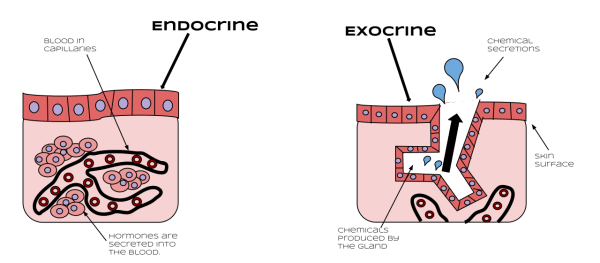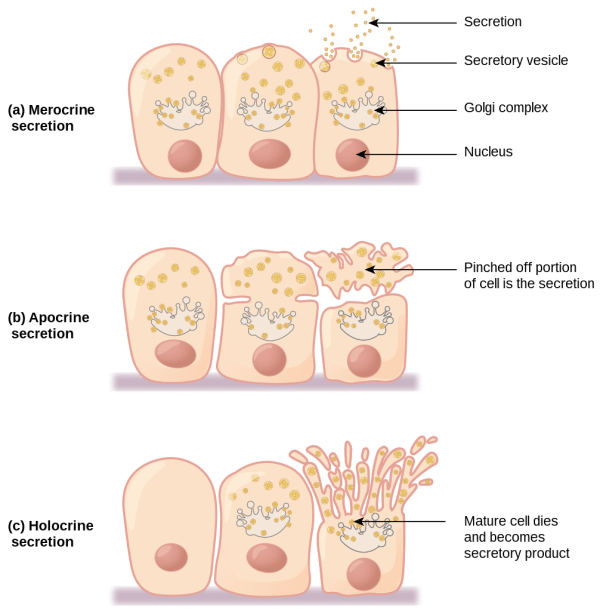Endocrine and Exocrine Glands
A gland is a group of cells which synthesise products to be released directly into the bloodstream (endocrine glands), or into a duct (exocrine glands).
Glands may produce and release hormones, a fluid such as sweat or bile, or a lipid-rich product (e.g. the meibum of the eye). The method of releasing the product depends on whether the gland is endocrine or exocrine (Figure 1).

Endocrine glands
Endocrine glands are ductless glands that secrete hormones directly into the bloodstream. Endocrine glands are typically highly vascular, to facilitate rapid delivery of their products into the general circulation.
Hormones are signalling molecules that regulate physiology and behaviour, such as metabolism, tissue function, and respiration.
Hormones facilitate communication between organs. Hormones can signal specific organs due to the presence or absence of receptor proteins on the cells of organs and connective tissues.
The major endocrine glands of the human body include the hypothalamus, pituitary gland, thyroid, parathyroid glands, thymus, adrenal glands, pineal gland, testes, and ovaries. Many organs and tissues exhibit baseline endocrine activity, such as the kidneys, stomach, and adipose tissue. The liver and pancreas exhibit both endocrine and exocrine activity. 1
Exocrine glands
Exocrine glands secrete substances onto an epithelial surface, such as the skin or the gastrointestinal tract, via a duct.
Ducts can be classified according to their shape:
- Simple ducts have one continuous secreting surface
- Compound ducts have multiple secreting surfaces, separated by non-secreting epithelium
- Alveolar or acinar ducts have an enlarged, spherical secretory portion
- Tubular ducts, as the name suggests, are tubular in shape
They can be further described by their orientation (e.g. coiled or branched). Some ducts have characteristics of multiple groups, such as the compound tubuloalveolar ducts of the salivary glands and pancreas. 2
Exocrine glands can also be categorised based on the type of secretory product they create:
- Serous cells secrete an isotonic fluid, which is often protein-rich (e.g. sweat glands)
- Mucous cells secrete a viscous product, high in carbohydrates (e.g. goblet cells, Brunner glands)
- Sebaceous cells secrete a lipid product (e.g. meibomian glands)
Glands can also be mixed, such as the salivary glands, which secrete protein and mucous.
Gland cells can also be classified according to their method of product delivery: 3

- Merocrine glands secrete their substances by exocytosis (e.g. eccrine sweat glands, goblet cells, and tear glands)
- Apocrine gland cells, such as mammary gland cells, concentrate material at their apical ends. Parts of their apical end then ‘bud off’ from the cell, taking part of the cell wall and cytoplasm
- Holocrine gland cells release their contents by rupture of the cell membrane, which kills the gland cell (e.g. sebaceous glands of the skin, the meibomian glands of the eyelid)
Clinical relevance: Sjögren’s syndrome
Sjögren’s syndrome is a chronic autoimmune disease that affects the lacrimal and salivary glands, leading to dry eyes (keratoconjunctivitis sicca) and dry mouth (xerostomia). Lymphocytic infiltration of the glands leads to their eventual destruction. Other exocrine glands may be involved, such as those lining the respiratory and gastrointestinal tracts.
While Sjögren syndrome can occur as an isolated disorder, it is often associated with another autoimmune disease, such as rheumatoid arthritis or SLE.
Inflammatory destruction of the lacrimal glands causes blurry vision, and painful, itchy eyes. Destruction of the salivary glands causes difficulty swallowing, a decrease in taste, and cracks and fissures of the buccal mucosa. Treatment is generally symptomatic and supportive. 4
Key points
- Endocrine ducts release substances directly into the blood, whether exocrine ducts deliver substances via a duct onto an epithelial surface.
- Exocrine glands can be classified according to their duct shape, their secretory product, and their method of product delivery.
Editor
Dr Chris Jefferies
References
- Hall JE, Hall ME. Guyton and Hall Textbook of Medical Physiology. 14 th Published in 2021.
- Freeman SC, Malik A, Basit H. Physiology, exocrine gland. Published in 2022. Available from: [LINK].
- Young B, O’Dowd G, Woodford P. Wheater’s Functional Histology: a text and colour atlas. 6 th Published in 2013.
- Kumar V, Abbas AK, Aster JC. Robbins and Cotran Pathologic Basis of Disease. 9 th Published in 2015.
Image references
- Mntrue15. Endocrine vs. Exocrine. Licence: [CC BY 4.0]
- Holly Fischer. TypesArrangements of Glands 1. Licence: [CC BY 3.0]
- Fred the Oyster. 405 Modes of Secretion by Glands updated. Licence: [CC BY 3.0]